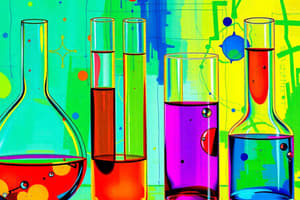Podcast
Questions and Answers
What is Gas Chromatography?
What is Gas Chromatography?
Separation technique based on differences in volatility and interaction with the stationary phase.
Factors that affect retention time include volatility of the compounds (vapor pressure), _____, and interaction between the compound and stationary phase.
Factors that affect retention time include volatility of the compounds (vapor pressure), _____, and interaction between the compound and stationary phase.
polarity
What is used to predict retention order?
What is used to predict retention order?
Based on polarity, boiling point, and intermolecular forces.
In the predicting retention order example, which compound has the highest boiling point?
In the predicting retention order example, which compound has the highest boiling point?
How do you calculate % Composition?
How do you calculate % Composition?
What does polarimetry detect?
What does polarimetry detect?
How can different isomers be distinguished?
How can different isomers be distinguished?
What determines observed rotations?
What determines observed rotations?
What is specific rotation?
What is specific rotation?
Which compound interacts more with the stationary phase in a 2:8 tert-butanol/ethanol mixture?
Which compound interacts more with the stationary phase in a 2:8 tert-butanol/ethanol mixture?
Compare the observed tR of ETBE with ethanol and tert-butanol.
Compare the observed tR of ETBE with ethanol and tert-butanol.
What will the order in retention time be when using a GC containing a polar stationary phase?
What will the order in retention time be when using a GC containing a polar stationary phase?
Rank the molecules from most retained to least retained.
Rank the molecules from most retained to least retained.
Flashcards are hidden until you start studying
Study Notes
Gas Chromatography
- Separation technique that relies on differences in volatility and interaction with a stationary phase.
- Retention time is influenced by factors such as the volatility of compounds, polarity, and the interaction between the compound and stationary phase.
Retention Order
- Predictive order based on the polarity, boiling point, and intermolecular forces of compounds.
- Example retention order: Alcohol > Ketone > Alkene due to differences in boiling points and polarity.
Percent Composition
- Calculated as (Area of Component 1 / Sum of Areas of All Components) x 100.
- Peaks in a chromatogram represent different compounds, with larger areas indicating higher percent composition.
Polarimetry
- Technique used to detect isomers by their ability to rotate polarized light.
- Utilizes sodium D light and a movable polarizing filter to measure angle; positive direction indicates clockwise rotation and negative indicates counterclockwise.
Isomer Differentiation
- Isomers interact differently in chiral environments and rotate polarized light at different angles.
- Observed rotations depend on experimental factors like cell length, sample concentration, and light wavelength.
Specific Rotation
- An intensive property useful for comparison between experimental and literature values.
- Specific rotation is crucial for identifying optical isomers.
Interaction with Stationary Phase
- Tert-butanol interacts more with stationary phase than ethanol due to higher boiling point and retention time.
- Higher boiling points correlate with longer retention times in gas chromatography; tert-butanol's long hydrocarbon chain supports interaction with non-polar stationary phases.
Observations with ETBE
- ETBE displays unique properties as a non-polar compound, lacking hydrogen bonding unlike ethanol and tert-butanol.
- ETBE shows the longest retention time, indicating strong interaction with a non-polar stationary phase, following expected trends in chromatography.
Retention Time Order
- In a gas chromatography setup with a polar stationary phase, ethanol (most polar) exhibits the longest retention time, while ETBE (most non-polar) has the shortest retention time due to minimal interaction with polar phases.
Retention Rankings
- Retention from most retained to least retained: Ethanol > Isopropanol > Tert-Butanol > Methyl Tert-Butyl Ether > Ethyl Tert-Butyl Ether.
Studying That Suits You
Use AI to generate personalized quizzes and flashcards to suit your learning preferences.



